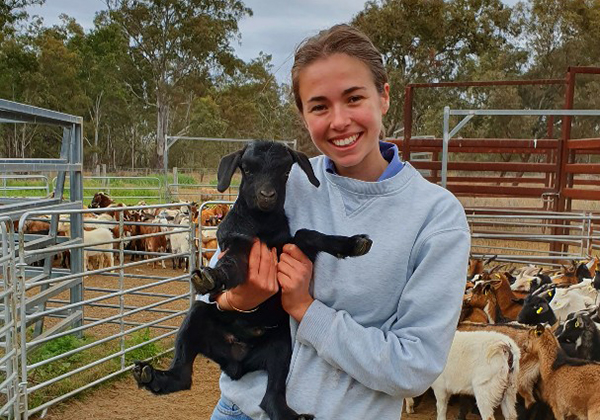 PhD candidate Kathryn Dawson has been awarded a new Goat Industry Capacity Building scholarship endorsed by GIRDAC. Image: Kathryn Dawson.
PhD candidate Kathryn Dawson has been awarded a new Goat Industry Capacity Building scholarship endorsed by GIRDAC. Image: Kathryn Dawson.
Scholarship to benefit goat industry
Key points
- PhD candidate Kathryn Dawson has been awarded a new Goat Industry Capacity Building scholarship endorsed by GIRDAC.
- Kathryn will use the scholarship to travel to field days and conferences to share practical information from her extensive research into goat parasite management.
- Her research project is investigating what parasites are present in key goat production regions of Queensland and New South Wales, and the efficacy of a range of drenches.
Kathryn Dawson will use a new Goat Industry Capacity Building scholarship to travel to field days and conferences to share insights from her extensive research into goat parasite management.
A goal to broadly share practical information about goat parasite management has led to Kathryn being awarded a new Goat Industry Capacity Building scholarship.
The scholarship is the first in a new form of professional development funds endorsed by the Goat Industry Research, Development and Adoption Committee (GIRDAC) and managed through MLA.
Kathryn, a PhD candidate at the University of Queensland’s School of Agriculture and Food Sustainability, is leading a research project investigating what parasites are present in key goat production regions of Queensland and New South Wales, and the efficacy of a range of drenches.
Working with goat producers, Kathryn has generated practical findings from the research to date, focusing on gastrointestinal nematodes, which are the most prevalent pathogenic parasites.
Kathryn will now use her scholarship to travel to field days and conferences to share her research findings more broadly.
“To date, I’ve done 3,500 worm egg counts for producers and we’re now up to the final experiment,” Kathryn said.
“My thesis will be submitted in September 2024, however, we already have a lot of information that is really useful to producers and the goat industry as a whole, but I didn’t have the funding myself in the university to really distribute it to the full extent.
“That’s why I applied for the new Goat Industry Capacity Building scholarship. I said in my application the main focus was to disseminate the research because it would really have a great benefit and impact on the industry.
“I’m adding value to parasite information and assisting producers with sharing what effect we have seen on-farm using a range of products we have tested.
“I’ve already attended quite a few field days and we always get a lot of questions from producers at those events, but they are quite expensive to attend, particularly when I’m working on a small budget as a student.
“I will use the scholarship money to attend field days and bigger conferences because I think the information is important to share with vets and researchers also, as not only an update for them, but also to see what research space still exists in the goat industry.”
Conferences and field days flagged
Kathryn hopes to attend the Australian Society for Parasitology annual conference in September in Darwin, and the joint Congress for the Australian Association of Animal Science (AAAS) and the Asian-Australasian Association of Animal Production (AAAP) in Melbourne in July 2024.
She is aiming to present her latest research findings at Collie Goat Production Field Day in 2024 and Goat Field Day in southern Queensland.
“The scholarship means I can now plan for those events, put the data together for presentations, and get the information out there,” Kathryn said.
“One of the main drivers for me doing this particular project for my PhD was because I wanted to do something that’s actually going to benefit producers now and generate findings they can apply on-farm.
“My passion and enthusiasm for it means the next step is to get that information out there and update its status.”
A wake-up call for producers
Kathryn said the parasite management results that have been achieved for producers involved in the research project have been encouraging.
“We’ve seen a lot of producers upset and overwhelmed by parasite burdens in their animals, particularly over the past two years of back-to-back wet years,” Kathryn said.
“But when you can help producers understand what parasites they have and the lifecycle, and what product will actually work on their farms, and then you follow up in a few months’ time and they are on top of it, it’s really rewarding to see them regain control of this particular problem and know the research you’re doing is making an impact.
“The last couple of years have been a wake-up call for producers.
“Even though you can have dry seasons and years without high parasite numbers, they can come back. The message is to be prepared for those seasons when they do reappear and not be on the back foot.”



